Scaffolding may be needed to keep you productive and safe. A scaffold may give you better access to the different sections of a building. The equipment needs to be secure, stable, and made of high-quality materials in order to ensure safety for those using it, as well as those near it. There are different things to consider when you need a scaffolding rental. It can be cheaper to rent scaffolding for short-term and smaller projects instead of buying.
Also read: Tips On How To Start A Profitable Pressure Washer Business
Table of Contents
The Rental Company
One of the most important factors you should consider when looking at a Scaffolding In Kent is the reputation of the rental company. You need to sit down and do your homework. Find a company that has been in business for years as proof of reliability. Another thing you should check is safety. There can be a lot of construction-related injuries involving scaffolding, so it’s important that you deal with rental companies that have valid permits and follow safety procedures and regulations. Apart from the reputation for safety, you should see if you can learn the accident history associated with the scaffolding rental company you are interested in.
Type of Construction Project
When looking at a scaffolding rental, it’s important to look at the type of construction project you have. There are different types of scaffoldings needed for different purposes. Using the right one will ensure productivity and convenience, as well as safety. For example, if you need a scaffold for some minor interior work then a foldable and compact system can be enough to do the job. If you have a project that requires a more specialized structure, then you will need to find a company that will rent you specialized equipment.
There are two different types of scaffolding to consider. Supported scaffolding includes a network of poles to support horizontal platforms. This is the most common type. The supports can be changed to accommodate the added weight of workers and equipment. Some of these types include frame, ladder jack, pump jack, or rolling. Frame scaffolding won’t move and is built from the ground up. It’s usually an inexpensive option and popular for long-term projects. It does require a lot of space around the building. Ladder jack scaffolding has two metal devices that attach to ladders in order to create a base. It’s suitable for lighter jobs and can’t support heavy equipment. Pump jack scaffolding has a moveable bracket that can easily be adjusted and is great for a task that needs to have adjustments for variable heights. Mobile scaffolding is great for projects where you need to move the scaffolding to complete another section of work. Suspended scaffolding has a platform with a guardrail system that can be raised down and up by ropes using an electric motor. This is a good choice when the work is on the upper floors of a building or the building is so tall that frame scaffolding won’t work. Repair contractors and window washers use this type of scaffolding.
Strength of the Scaffolds
Since your scaffold carries the weight of the equipment and workers you may need to test the strength before you rent it. Pay attention to the base of the scaffold. The base should be stable and well-built so that it supports the height of the platform. If the project requires a towering structure then you need to make sure you have steadiness and strength at the base.
Payment Terms
It’s always a good idea to look at the payment terms provided by the company. You should know and understand every term, including the initial cost and the basis for any additional charge. It’s a red flag if the firm refuses to present a breakdown of the fees. Keep in mind how long you need the equipment for and if there is a cost associated with needing it for an extended period. What if the project is going to be longer than expected? It may be helpful to work with a company that has flexible payment solutions for these instances. You also don’t want to pay less for scaffolding at the expense of safety. Be sure to rent the scaffolding pieces that are necessary for a safe working environment, including guardrails, even for lower heights.

